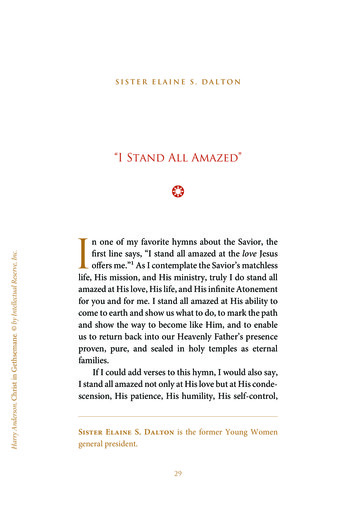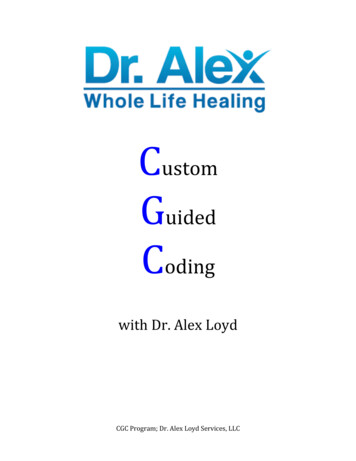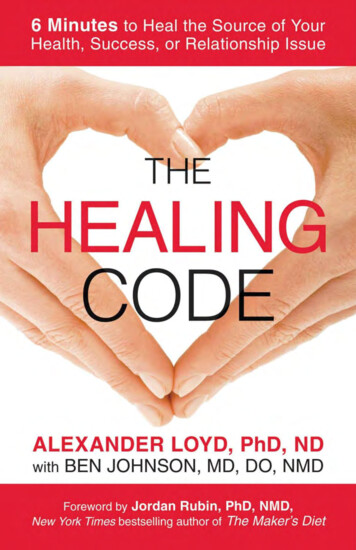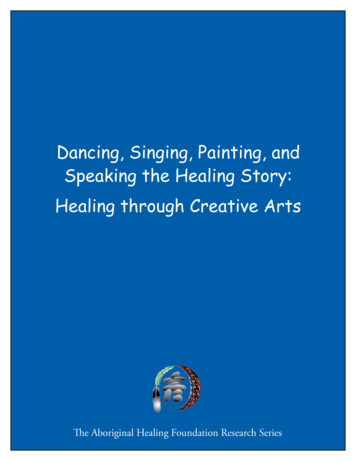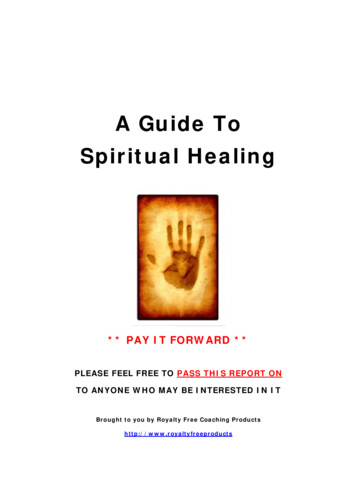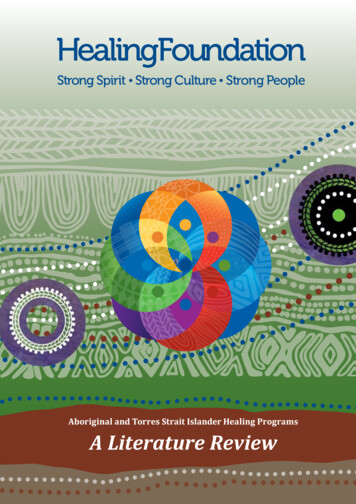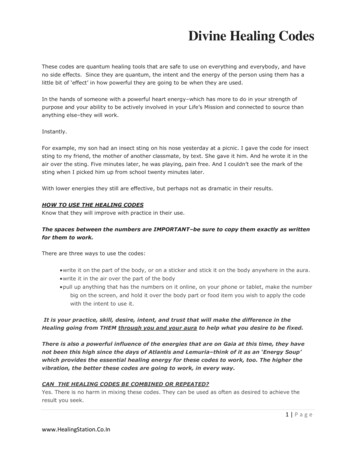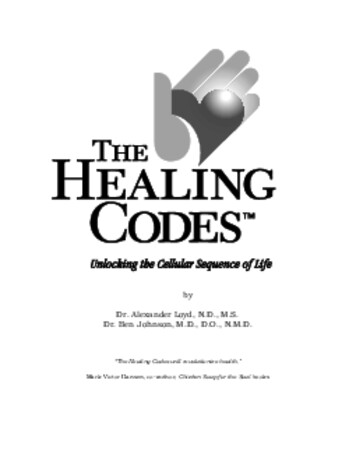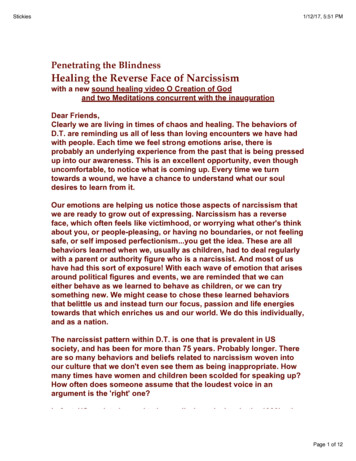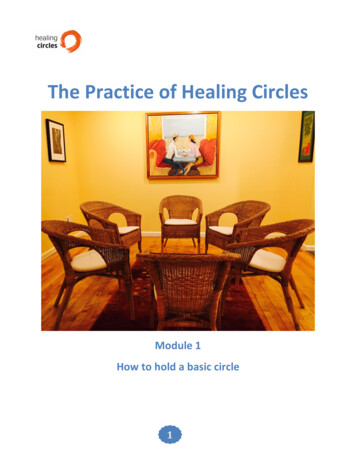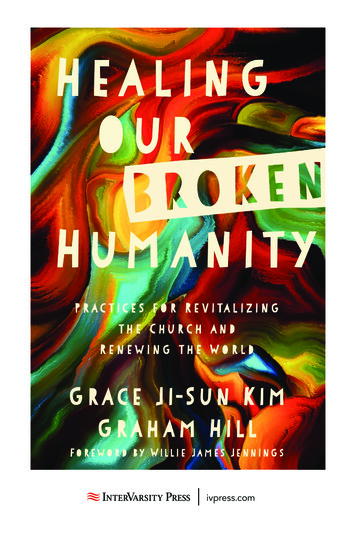
Transcription
ivpress.com
Taken from Healing Our Broken Humanityby Grace Ji-Sun Kim and Graham Hill.Copyright 2018 by Grace Ji-Sun Kim and Graham J. G. Hill.Published by InterVarsity Press,Downers Grove, IL. www.ivpress.com
INTRODUCTIONNine Practices That HealOur Broken HumanityOn July 17, 2014, Eric Garner died after a police officer put him ina chokehold for almost nineteen seconds while arresting him.Garner was a forty-three-year-old African American man. He waswrestled to the ground by four police officers on suspicion of sellingsingle cigarettes from packs without tax stamps. While one officer puthis arm around Garner’s neck, three others pinned him to the ground.Garner repeated “I can’t breathe” eleven times while lying facedownon the pavement. He then lost consciousness, and the officers did notperform CPR at the scene. Garner died that day due to the brutalityof his arrest.In 2015 Ta-Nehisi Coates wrote a public letter to his son. In it hewrites, “Here is what I would like for you to know. In America, it istradition to destroy the black body—it is heritage.”1 He then askedreaders of The Atlantic to share their stories of racial prejudice. Manystories of racism and its consequences poured in. These are personalstories of racism, and public accounts of the brokenness of humanity.We are living in a broken world. Western societies are strugglingwith the rise of racism, misogyny, nationalism, conflict, violence, andmore. Many African Americans, Native Americans, Latinx, AsianAmericans, and other minoritized groups think that systems areHealingOurBroken 7 June 5, 2018 11:57 AM
8Introductionunjust.2 Political, judicial, policing, and other systems seem stackedagainst them. Hundreds of thousands of people are displaced globallydue to poverty, discrimination, climate change, or political and religious upheaval. They seek refuge, hope, freedom, and a new life.Many political and public figures are making the most of theseturbulent times. They appeal to xenophobia, nationalism, and antagonisms. These messages have been magnetic in parts of NorthAmerica, Europe, Australia, and other settings. The conditions seemripe to support racism, misogyny, exclusion, injustice, conflict, anddivision. Nations and peoples that once enjoyed unrivaled globalpower and influence now feel like they are in decline, and they don’tknow what to do about it.A large percentage of the population feels disenfranchised from political and other systems that seem to support wealthy individuals andinstitutions. These systems seem deaf to them. They feel anxious,worried about the future, angry, and disoriented. They see themselvesgetting poorer. They see their neighborhoods becoming racially andreligiously diverse. So they are looking for others to blame. Muslims,“foreigners,” or undocumented immigrants are easy scapegoats. Societies that have been told how to speak about race, gender, and religionhaven’t really changed. They’ve just pushed these feelings and animosities down deeper, resulting in collective anger, prejudice, and fear.Unfortunately, many Christian leaders and churches are goingalong with these currents. The church is no longer at the center ofculture, power, economics, and politics, as it was in Christendom.Some Christian leaders are anxious about their waning influence.They worry about their loss of power and status. They’re easy to woobecause they want their chance in the spotlight and their access topower and the powerful. Various tribal allegiances too often formChristian identity. Confident, charismatic, successful, misogynistic,nationalistic, Christendom-courting, loudmouthed demagogueshave filled the vacuum.HealingOurBroken 8 June 5, 2018 11:57 AM
Introduction9But here is the bright side! The church of Jesus Christ can speaklife and hope into this situation. It can proclaim and embody the newcreation in Christ, and show a different ethic and way of life in theworld. God enables us, as God’s one, new, and transformed people, torecover our humanity and help change the world. After all, we followthe one who goes into the storm saying, “Peace, be still.”The way the church embodies this new way of life in the world isits shared practices.The Power of PracticesI (Graham) grew up in a suburb and family full of craftspeople andtradespeople. These were people skilled in a range of functional, decorative, or specialized crafts and trades. These included carpenters,tailors, stonemasons, builders, bricklayers, and electricians. It included floorers, landscapers, plumbers, roofers, welders, truckdrivers, automotive mechanics, architects, and cabinetmakers. Allplied their craft with skill. They made commitments to apprenticingone, two, or three others in their craft or trade. All honed their expertise. They saw their craft or trade in the light of the broader community of artisans. They worked together, building or renovatinghouses, sculpting landscapes, restoring automobiles, or fashioninggarments or pieces of furniture.The finished product was rarely the result of one craft or oneartisan working alone. At times these tradespeople or craftspeoplewere only skilled in one area. But often they were multiskilled:carpenter-floorers, plumber-electricians, architect-landscapers,truckie-mechanics, or teacher-builder-electricians. My father restoredhouses from time to time—including my own house, after my wife,Felicity, and I moved to Sydney, Australia. When he did this he usedan array of carpentry, electrical, plumbing, construction, architectural, roofing, flooring, and landscaping skills. And he called on theskills of others he trusted.HealingOurBroken 9 June 5, 2018 11:57 AM
10IntroductionIn that environment I learned the importance of discipline andpractice, both personal and in community. A person becomes a highlyskilled craftsperson or tradesperson (or dancer, musician, theologian,pastor, writer, etc.) through many years of hard work and personaldiscipline. This person, and the community the person is a part of,performs important, disciplined practices countless times, over manyyears. These practices form people personally, build the community’slife together, and shape the fruit of people’s lives and shared efforts.This is a community of discipline. It is a practicing community. Thesepractices often lead to extraordinary and beautiful results.I (Grace) have a teenage daughter, Elisabeth, who’s an example ofthe power of disciplines and practices. Elisabeth has been takingballet lessons since she was three years old. When she turned eight,her dance became more and more serious, and she had to focus andbecome a disciplined dancer. She goes to ballet four to seven days aweek. When there are performances such as The Nutcracker or thespring dance, she is at her ballet studio for three to five hours per dayto warm up, stretch, rehearse, and learn new routines. It takes skill todance, but also lots and lots of practice to become a good dancer.Elisabeth takes her classes and rehearsals very seriously. In classthe dancers are not allowed to talk unless the instructor asks them aquestion. They are expected to quietly follow directions and practicenew moves. There is a lot of repetition; the instructor makes them domovements over and over again until they have mastered them. Theteacher points out what dancers are doing right or wrong and alsouses a hands-on approach to lift or stretch their legs or arms properly.After hundreds of repetitions of the same movement, the studentscome to learn it.Furthermore, after Elisabeth’s dance classes and rehearsals, shecomes home and does her homework and studies for her tests. Beforebed she spends thirty minutes stretching and exercising. She is verycareful about what she eats, doing her best to stay away from junkHealingOurBroken 10 June 5, 2018 11:57 AM
Introduction11food and to eat fresh fruits and vegetables. She recognizes that ahealthy body is needed to be a serious dancer.Elisabeth’s classes, routines, rehearsals, and healthy lifestyle arecrucial to becoming a dancer. They have become part of her lifestyle,and they are all essential. The rest of us, whether we want to becomea dancer or a faithful disciple of Christ, need to engage in similarlytransforming practices.Stanley Hauerwas says that formation happens in community.3This is because character is at the center of formation, and communityforms character. Today we as Christians need to recover, as Hauerwaswrites, “the integrity of the Christian community. Here is a community breaking out of the suffocating tyranny of American individualism in which each of us is made into his or her own tyrant. Hereis an alternative people who exist, not because each of us made uphis or her own mind but because we are called, called to submit ourlives to the authority of the saints.”4 Hauerwas believes that we arecalled to submit ourselves to Christ and to a faithful community thatpractices its discipleship together.In this community of character are individuals. They form anethical life together and in the world through discipleship practices.These include Eucharist, simplicity, generosity, economic sharing,hospitality, creation care, reconciliation, peacemaking, and acts ofjustice. They include prayer, baptism, celebrating the liturgy, readingScripture, fasting, serving with the mentally handicapped, and embracing asylum seekers, refugees, and undocumented neighbors. Importantly, they include immersing ourselves in the Gospels as thetraining manuals for Christian discipleship.Formational practices need disciplined communities. But, as Hauerwas notes, shaping disciplined communities isn’t easy. It’s especially hard in modern, liberal-democratic, consumeristic, and individualistic societies. So much in these societies pushes back againstdiscipline, accountability, stability, and community.5 But discipleshipand community must go hand in hand.6HealingOurBroken 11 June 5, 2018 11:57 AM
12IntroductionHauerwas draws on the metaphor of bricklaying. He says thechurch needs to learn to lay metaphorical bricks and to make disciples. Laying bricks involves “learning myriad skills, but also a language that forms and is formed by those skills.”7 It’s about learningthe craft from those who’ve gone before. It isn’t primarily about gathering information. It’s about discipline, training, craft, language, patience, character, and formation in community. This is how thechurch must make disciples. Discipleship involves learning a myriadof skills through personal discipline and by immersion in community.We also learn a language—words such as faith and hope and love takeform in our mouths and shape our hearts and minds. And, so, discipleship practices and new ways of conceiving and speaking aboutGod and the world shape our life together. Together, we learn freshdiscipleship practices and vocabularies.Nine Transforming PracticesThis book shows what it means to be the church, the new humanityin Jesus Christ, as Paul writes about in Ephesians 2:15. This is thebiblical basis for our understanding of what it means to become newin Christ. The church shows the world God’s perfect design for humanity, which is a reconciled, unified, whole, multiethnic, peaceful,loving life together. As a beacon to the world, the church shows theworld what God calls it to be. The church shows the world its destinyand future. In an era where Christian identities seem so enmeshedwith race, politics, nationalism, and material goods, we need toimagine a different reality.8In The Christian Imagination, Willie James Jennings has shownhow the Christian social imagination is often diseased and disfigured.It’s wedded to racialized, individualistic, privatized, and rootless identities. We find ourselves in this place because of historical events. Weneed to confront this situation head-on and theologically if we aregoing to demonstrate a compelling witness and life together in theHealingOurBroken 12 June 5, 2018 11:57 AM
13Introductionworld. The church needs a compelling vision of a healed and wholeChristian community (and a redeemed Christian social imagination).The church needs fresh practices before a watching world.Too often our theological or intellectual posture is one of powerand control. We expect others (e.g., indigenes, marginalized groups,and outsiders) to be adaptable, but we refuse to be so ourselves. Inour attachment to power and control, rigidity, superiority, andstaleness grow. This diseased posture stops Christians from forminghabits of humility, fluidity, embodiment, and engagement, whichlead to transformation. Yet, as Jennings says, we live in hope:Christianity marks the spot where, if noble dream joins handswith God-inspired hope and presses with great impatienceagainst the insularities of life, for example, national, cultural,ethnic, economic, sexual, and racial, seeking the deeper groundupon which to seed a new way of belonging and living together,then we will find together not simply a new ground, not simplya new seed, but a life already prepared and offered to us.9Race relations is one area where the church and Christianity canoffer hope and a new way of life together. Race is a modern constructand problem, and such disciplines as biology, genetics, philosophy,history, political science, economics, feminism, cultural and post colonial studies, and more are examining it. We need to understand“whiteness” and how whiteness is a construct to subordinate others.Yet, strangely, Christian theologians have been largely silent aboutrace. A theological account of race is profoundly absent.A few theologians and authors are seeking to fill this void. WillieJames Jennings, Daniel Hill, Soong-Chan Rah, Christena Cleveland,Kwok Pui Lan, J. Kameron Carter, Drew G. I. Hart, Brenda SalterMcNeil, Rick Richardson, Jim Wallis, Emmanuel Katongole, KenWytsma, Paula Harris, and Doug Schaupp are examples. They call thechurch to a new way of life together in the world in terms of raceHealingOurBroken 13 June 5, 2018 11:57 AM
14Introductionrelations. This is a way of life characterized by justice, love, reconciliation, and peacemaking. These authors exemplify Christian hope forsociety in regard to this important topic.This book unpacks what it means to be the new humanity inChrist, as we embrace nine transforming practices that we hope youcan adopt into your life. The practices aren’t necessarily sequential.You don’t need to practice the fourth before you can go to the fifth, forexample. These practices may be taking place concurrently, and different people might have different entry points.1. Reimagine church as the new humanity in Jesus Christ.2. Renew lament through corporate expressions of deep regret andsorrow.3. Repent together of white cultural captivity, and racial and genderinjustice, and of our complicity.4. Relinquish power by giving up our own righteousness, status,privilege, selfish ambition, self-interests, vain conceit, andpersonal gain.5. Restore justice to those who have been denied justice.6. Reactivate hospitality by rejecting division and exclusion, andwelcoming all kinds of people into the household of God.7. Reinforce agency by supporting people’s ability to make free,independent, and unfettered actions and choices.8. Reconcile relationships through repentance, forgiveness, justice,and partnership.9. Recover life together as a transformed community that lives outthe vision of the Sermon on the Mount.These nine practices enable us to be the new humanity in Jesus Christ.These nine practices transform the church and the world. They leadto reconciliation, justice, unity, peace, and love.HealingOurBroken 14 June 5, 2018 11:57 AM
Introduction15Who We Are and Why We ArePassionate About This BookWe want to take a moment to introduce ourselves and explain whywe wrote this book. We’ve known each other for a few years now,since we first met when Graham did some filming with Grace for theGlobalChurch Project. Graham spent almost six months filmingAsian, African, Latin American, indigenous, and diaspora Christianleaders about faith, witness, prayer, and more, and he caught up withGrace in New Jersey in early 2015 to do some filming with her on herwritings. Over a couple of years, we shared stories about our passionfor listening to the voices of minoritized people. We discovered ashared desire to invite often-unheard voices from around the worldto enter into a powerful conversation about the shape of faith, reconciliation, and justice in the twenty-first century. In the process webecame close friends and decided to write about these things together.I (Graham) teach applied theology and world Christianity atMorling Theological College in Sydney, Australia. I’m the foundingdirector of the GlobalChurch Project. I’ve been in Christian ministrysince 1987, including church planting, pastoring local churches, andteaching at theological colleges. I’m passionate about the local churchand about seeing neighborhoods and lives transformed.I (Grace) am an associate professor of theology at Earlham Schoolof Religion in Indiana, and I am an ordained Presbyterian Church(USA) minister. I have written several books on marginality, racism,sexism, and the need to embrace all people. As I grew up in Canadaas a young immigrant child, it became very clear that my voice wasoften ignored. I experienced this firsthand in my elementary school.Because my first language isn’t English, kids made fun of my accentevery time I opened my mouth. This made me feel self-consciousabout speaking out loud in the classroom. So even though I wantedto speak up and answer questions that the teacher was asking, I feltthat I couldn’t participate as I wanted, and as a result my voice becameHealingOurBroken 15 June 5, 2018 11:57 AM
16Introductionmore and more silenced. In addition my voice was ignored in theKorean Presbyterian church that I grew up in. It was quite evidentthat male voices were welcomed, and women’s voices were considered unimportant and a nuisance. The blatant silencing of women’svoices was a painful reality for me and for other women in the church.I (Graham) first became passionate about the transforming practices covered in this book in the late 1990s, when I was speaking at aconference in Manila in the Philippines. I was staying in a backpacker’s hostel at night and speaking at conference sessions duringthe day. One morning I was woken by the sound of sobbing. I lookeddown from my bunk to see an elderly man weeping beside his bed.During the week I got to know this remarkable man. He was an elderly Vietnamese pastor who’d planted a church of a dozen people inhis home thirty years earlier. That church had grown to tens of thousands of people. He told me stories from this Vietnamese church thatsounded like something from the book of Acts. These were stories ofmiracles, lives transformed, persecution, and a growing, vibrant, underground church in communist Vietnam. But I noticed something.All the speakers at the conference in Manila looked like me: whitemen. So I started thinking about the injustice of this. Why weren’tpeople like my elderly Vietnamese friend asked to speak, or at leastto tell their stories? And I started wondering about the thousands andthousands of stories that are never heard: Christians whose voices areignored, silenced, or marginalized. How do we start to hear thesevoices? How do we hear their cries for (and stories of) justice, peace,hope, and reconciliation? How do we learn from them and embracenew practices that can transform the world? That was the beginningof my journey, and these nine practices come out of listening to thousands of Christians from all over the world talk about the practicesthat they know can heal our broken world.Our hope is that this book will be used by small groups, ministryprofessionals, activists, and laypeople. We hope this book will helpHealingOurBroken 16 June 5, 2018 11:57 AM
17Introductionyou discover new, transforming practices that revitalize the churchand its mission and that transform the world. We hope that throughthese nine practices you’ll discover fresh expressions and depths ofreconciliation, justice, unity, peace, and love.How to Get the Most Out of This BookThis book can be read individually, but we also believe it is helpful toread in community. We encourage you to read this book in your smallgroup, as a ministry team, as a college class, or in some other groupsetting. You may choose to gather a group of friends and read thisbook together in a home or a coffee shop.Here’s how your group can get the most out of this Figure 1. Practices for getting the most out of this bookHealingOurBroken 17 June 5, 2018 11:57 AM
18IntroductionPray for open hearts. Spend time together in prayer and meditation, asking God to prepare your hearts as you read the chaptertogether. Ask the Spirit to make you open to what God wants to do inyour lives, group, church, and neighborhood. Ask God to give you anopen and receptive heart.Read the chapter. Before your meeting, read through the chapterfor the week. Many of the chapters refer to Scripture too, so read withyour Bible open. Read slowly, reflectively, and prayerfully. Take yourtime and allow the ideas and challenges to sink in. (If you are readingthis book together in your small group, you might choose to do onepractice per week over nine weeks, or two practices per week overfour weeks, and then one in a final week.)Journal your thoughts. As you read the chapter, journal yourthoughts. Journal what God is saying to you. How is God asking youto respond and change? What impresses or challenges you? What doyou agree or disagree with? What questions do you have? How is theSpirit trying to get your attention and change your life? What is hesaying to your group, church, and neighborhood? How is God callingyou to think or act in response to your reading?Discuss what you are learning. Meet in a small group or collegeclass, with some friends at home or at a coffee shop, or as part of aministry team. You will get a lot more out of this book when you readit with others. Together you can think about the book’s challengesand implications. Discuss the chapter you read that week (or the twochapters you read that week, if you’ve decided to work through thisbook over five weeks). What are the key ideas? How does the chapterinvite your group to respond? What does the chapter mean for yourministry, church, agency, family, or team? Appendix one has somequestions for discussion and application.Act on the suggested practices and activities. At the end of everychapter, there are three or more practices, challenges, and activitiesfor small groups. These will help you explore and apply the practiceHealingOurBroken 18 June 5, 2018 11:57 AM
Introduction19discussed in that chapter and turn ideas into habits. Choose one ofthe suggested activities to do together that week. Set aside some timeto do that activity together. (If an activity can’t be completed thatweek, set aside some time in your calendar to do that activity later on.Some of the activities will take quite a few weeks to complete, so setaside some time to do that exercise this year.)Reflect on what you are learning. As you do the small group practiceor exercise together, talk through what you are learning. When youmeet to read the next chapter, reflect together on what God is sayingto you and how God wants you to respond personally and as a group.What did you learn and discover as you engaged in the small groupactivity together? Engage with each other’s ideas. Listen and learnfrom each other’s insights and experiences.Encourage each other to change and grow. We all find it easier tochange and grow when we are encouraged and supported. Find creative ways to encourage each other to pursue deeper discipleship andfaith and to overcome old habits and prejudices. We encourage eachother by (1) discerning together what God is saying to us, (2) spurringeach other on to deeper faith, (3) challenging each other to change,(4) nurturing each other’s faith, and (5) holding each other accountable.Here’s one way you can keep each other accountable. Appendixtwo has the “Nine Transforming Practices Accountability Form.” Keepa copy of this form in your Bible or in your bag or journal.Once a week, pull out this form and write some answers to the questions on the form.Once a month, ask everyone in your group to pull out their forms,and then discuss each of the nine practices. Hold each other accountable for the commitments you make. This accountability willhelp you continue to change and grow.Grow through further reading. It’s important to keep growing andlearning. Appendix three has resources for recovering our humanity.These are a few books on each of the nine practices that will help youlearn more about the practice and how to apply it.HealingOurBroken 19 June 5, 2018 11:57 AM
20IntroductionSmall Group Resources in This BookTo help your group get the most out of this book, we’ve included thefollowing four resources: Small group activities are proposed at the end of every chapter.These will help you apply the nine practices in your church andneighborhood. Questions for discussion and application are in appendix one.These will help you dig deeper into how to apply and understand each of the nine practices. The Nine Transforming Practices Accountability Form is in appendix two. This will help you keep each other accountable asyou seek to live out the nine practices personally and together. Resources for recovering our humanity are offered in appendixthree. These will help you to learn more about each of the practices and help you continue to grow.Small ountabilityFormFurtherResourcesFigure 2. Resources in this bookWith God’s help, we can recover our humanity and pursue love,peace, justice, and reconciliation. These nine practices help encourageus to transform a dehumanized world into God’s world.HealingOurBroken 20 June 5, 2018 11:57 AM
OneREIMAGINECHURCHJesus calls us to reimagine the church as the new humanity inJesus Christ (Eph 2:15).This is about learning together and anew about injustice and di-vision in the church and the world. It’s also about learning mutuallyand afresh what it means to be the new humanity in Jesus Christ.What Is “the New Humanity in Christ”?As a child I (Graham) had the opportunity to visit the junction wherethe Darling and Murray Rivers meet and join in New South Wales,Australia. These are some of Australia’s longest rivers. There’s aviewing tower at the junction. A huge sign declares, “You are at thejunction of Australia’s Two Greatest Rivers.” From the tower you cansee the distinct difference between these two great rivers. Surroundedby majestic eucalyptus trees and the laughter of kookaburras, youlook down on these rivers. The Darling River stretches 915 miles. It’sa clay-based river and has a rich milky color. The Murray River is 1,558miles long, and it flows through Australia’s highest mountains allthe way to the sea. It’s a rich ecosystem of fish, turtles, shrimp, andplatypuses, and it’s a vibrant blue.HealingOurBroken 21June 5, 2018 11:57 AM
22Healing Our Broken HumanityAt the Darling and Murray Rivers junction, these two rivers becomeone great river. This is a stunning testimony to the God who creates,sustains, and restores all the heavens and the earth, and who makesthe two into one.What does Paul the apostle mean when he speaks of the new humanity in Christ?Paul means that Jesus Christ has done away with the old divisionsand enmities. He has united Jews and Gentiles as one new and un divided humanity in him through his death and resurrection. This isa new creation in Christ. God has made for Godself one new peopleout of the two. Christ has abolished the old divisions based on culture,politics, race, religion, law, gender, social standing, and so on. “Christis all, and is in all” (Col 3:11) and has brought us together from everynation, language, and people as “one new people.” This doesn’t rid usof our Jewish or Gentile (or American, Korean, Australian, Chinese,Rwandan, Brazilian, Native American, etc.) cultures, identities, andunique contributions. But now our primary identity is in Christ andin that he has made us “one new humanity” in him (Eph 2:15; see Eph2–4; Col 3; Gal 3; 6).The political culture has become more polarized than ever inrecent years. Sadly, many American Christians participated in thisculture of divisiveness and animosity. Misunderstanding, accusations, and disunity continue in the church, even after the 2016election. It’s one thing to differ and engage in vigorous debate. Butdisunity, animosity, and division are another thing altogether.Much of this division is rooted in our sense of personal and corporate identities. But Jesus calls us to shape new identities as the newhumanity in Christ. This new identity forges new allegiances and newsocial imaginations. It nurtures a deep commitment to grace, forgiveness, and love. In a world full of division and conflict, the churchneeds to embrace the ministry of reconciliation and peacemaking.God calls us to be a peaceable people who display unity in diversityHealingOurBroken 22 June 5, 2018 11:57 AM
Reimagine Church23under Christ. God commands us to show the world what it means tobe a new humanity and new creation in Christ.So we are not primarily Tutsi or Hutu, German or French, Britishor Australian, Palestinian or Israeli, Chinese or Brazilian, Syrian orAmerican. We are not primarily Republican or Democrat, conservative or progressive, urban or rural, rich or poor, white or a personof color. We bring all these identities and aspects of ourselves to ournew humanity in Christ. We are primarily one people, united as onebody in Jesus Christ. As a new creation and a new humanity, we are“a people on pilgrimage together, a mixed group, bearing witness to anew identity made possible by
practices often lead to extraordinary and beautiful results. I (Grace) have a teenage daughter, Elisabeth, who’s an example of the power of disciplines and practices. Elisabeth has been taking ballet lessons since she was three years old. When she turned eight, her dan
